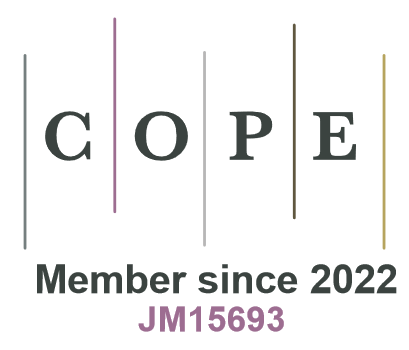Sex differences in relationship between body composition and digit length ratio (2D:4D) in students of military courses
DOI:
https://doi.org/10.2478/anre-2018-0034Keywords:
body composition, military students, digit ratio, 2D:4D, prenatal testosteroneAbstract
It is believed that the second to fourth finger length ratio is an indirect indicator of fetal testosterone levels. It is pointed out that there is a relationship between the 2nd to 4th finger length ratio and the body structure in women and men. Studies on the relationship between body composition and 2D:4D finger length among military students have not been carried out so far. The work aims to determine the dependence of body composition and the quotient of the 2nd and 4th fingers length of military students. The research material has been gathered as a result of examinations of women and men studying military subjects. The study involved 55 women and 65 men. The tests included anthropometric measurements (body height, body weight, length of the second and the fourth fingers) and body composition measurements. As a result of the tests, no dimorphic differentiations in the digit length ratio (2D:4D) was indicated. The BMI, muscle mass, lean body mass and water in the body demonstrated higher values in men than in women. However, the fat content in men was low. It was found that the relationship exists between muscle mass, lean mass and total water content in the body and the 2D:4D finger length ratio in the left hand in women. A higher level of fetal testosterone, characterized by lower values of the 2nd to 4th finger length ratio, may be associated with a higher content of muscle mass, lean body mass and water in the body of adult women leading a similar lifestyle.
Downloads
References
Apicella CL, Dreber A, Campbell B, Gray PB, Hoffman M, Little AC. 2008. Testosterone and financial risk preferences. Evol Hum Behav 29(6):384-90.
View in Google Scholar
Beals K, Darnell ME, Lovalekar M, Baker RA, Nagai T, San-Adams T, et al. 2015. Suboptimal Nutritional Characteristics in Male and Female Soldiers Compared to Sports Nutrition Guidelines. Mil Med 180(12):1239-46.
View in Google Scholar
Bielicki T, Szklarska A, Kozieł S, Welon Z. 2003. Transformacja ustrojowa w Polsce w świetle antropologicznych badań 19-letnich mężczyzn. Monografie Zakładu Antropologii PAN, Wrocław.
View in Google Scholar
Bohm A, Heitmann BL. 2013. The use of bioelectrical impedance analysis for body composition in epidemiological studies. Eur J Clin Nutr 67(1):579-85.
View in Google Scholar
Coates JM, Gurnell M, Rustichini A. 2009. Second-to-fourth digit ratio predicts success among high-frequency financial traders. Proc Natl Acad Sci 106(2):623-28.
View in Google Scholar
Doliński M, Ignasiak Z. 2001. Poziom zdolności motorycznych w kategoriach BMI kandydatów do wyższej szkoły oficerskiej. In: M Sokołowski, editor. Morfofunkcjonalne uwarunkowania i skutki służby wojskowej. Poznań: WSO im. Stefana Czarnieckiego.
View in Google Scholar
Eler N. 2018. The correlation between right hand finger ratio (2D:4D) and the parameters of anthropometric and physical fitness in children. J Hum Sci 15(1):656-64.
View in Google Scholar
Fink B, Manning JT, Neave N. 2006a. The 2D:4D digit ratio (2D:4D) and neck circumference: implications for risk factors in coronary heart disease. Int J Obes 30(4):711-14.
View in Google Scholar
Fink B, Neave N, Laughton K, Manning JT. (2006b): Second to fourth digit ratio and sensation seeking. Pers Individ Dif 41(7):1253-62.
View in Google Scholar
Fink B, Neave N, Manning JT. 2003. Second to fourth digit ratio, body mass index, waist-to-hip ratio, and waist-to-chest ratio: their relationships in heterosexual men and women. Ann Hum Biol 30(6):728-38.
View in Google Scholar
Folland JP, McCauley TM, Phypers C, Hanson B, Mastana SS. 2012. Relationship of 2D:4D finger ratio with muscle strength, testosterone, and androgen receptor CAG repeat genotype. Am J Phys Anthropol 148(1):81-7.
View in Google Scholar
Galis F, Ten Broek CMA, Van Dongen S, Wijnaendts LCD. 2010. Sexual dimorphism in the prenatal digit ratio (2D:4D). Arch Se XBehav 39(1):57-62.
View in Google Scholar
Garbarino E, Slonim R, Sydnor J. 2011. Digit ratios (2D:4D) as predictors of risky decision making for both sexes. J Risk Uncert 42(1):1-26.
View in Google Scholar
Garn SM, Burdi AR, Babler WJ, Stinson S. 1975. Early prenatal attainment of adult metacarpal-phalangeal rankings and proportions. Am J Phys Anthropol 43:327-32.
View in Google Scholar
Goodyear MDE, Krleza-Jeric K, Lemmens T. 2007. The Declaration of Helsinki. Br Med J 335:624-25.
View in Google Scholar
Goymann W, Wingfield JC. 2014. Male-to-female testosterone ratios, dimorphism, and life history-what does it really tell us? Behav Ecol 25(4):685-99.
View in Google Scholar
Gutiérrez R, Aldea L, Cavia M, Alonso-Torre S. 2015. Relation between the body composition and the sports practice in teenagers. Nutr Hosp 32(1):336-45.
View in Google Scholar
Hampson E, Ellis CL, Tenk CM. 2008. On the relation between 2D:4D and sex-dimorphic personality traits. Arch Sex Behav 37(1):133-44.
View in Google Scholar
Hughes VA, Frontera WR, Roubenoff R, Evans WJ, Singh MAF. 2002. Longitudinal changes in body composition in older men and women: role of body weight change and physical activity. Am J Clin Nutr 76(2):473-81.
View in Google Scholar
Kalichman L, Batsevich V, Kobyliansky E. 2017. Finger Length Ratio and Body composition in Chuvashians. Coll Antropol 41(1):25-30.
View in Google Scholar
Kociuba M, Kozieł S, Chakraborty R. 2016. Sex differences in digit ratio (2d:4d) among military and civil cohorts at a military academy in Wrocław, Poland. J Biosoc Sci 48(5):658-71.
View in Google Scholar
Kociuba M, Kozieł S, Chakraborty R, Ignasiak Z. 2017. Sports preference and digit ratio (2D:4D) among female students in Wrocław, Poland. J Biosoc Sci 49(5):623-33.
View in Google Scholar
Kozieł S, Kociuba M, Chakraborty R, Ignasiak Z. 2017. Physical Fitness And Digit Ratio (2D:4D) In Male Students From Wrocław, Poland. Coll Antropol 41(1):31-7.
View in Google Scholar
Kozieł S, Kociuba M, Chakraborty R, Sitek A, Ignasiak Z. 2018. Further evidence of an association between low second-to-fourth digit ratio (2d:4d) and selection for the uniformed services: a study among police personnel in Wrocław, Poland. J Biosoc Sci 50(4):527-39.
View in Google Scholar
Kozieł S, Kociuba M, Ignasiak Z, Chakraborty R. 2016. Is sports choice and participation related to 2D:4D? A study among adult male students in Wrocław, Poland. Coll Antropol 40(2):105-10.
View in Google Scholar
Králík M, Gronkiewicz S, Ingrová P, Kozieł S. 2014. Changes in digit ratio during puberty: X-ray sample from the Wrocław Longitudinal Study of Twins. Academy of Sciences of the Czech Republic 3:187-89.
View in Google Scholar
Lutchmaya S, Baron-Cohen S, Raggatt P, Knickmeyer R, Manning JT. 2004. 2nd to 4th digit ratios, fetal testosterone and estradiol. Early Hum Dev 77(1-2):23-8.
View in Google Scholar
Majumder J, Bagepally BS. 2015. The right hand second to fourth digit ratio (2D:4D) and its relationship with body composition indicators among young population. Asian J Med Sci 6(2):78-84.
View in Google Scholar
Manning JT, Churchill AJ, Peters M. 2007. The effects of sex ethnicity and sexual orientation on sefl-measured Digit Ratio (2D:4D). Arch Sex Behav 36(2):223-33.
View in Google Scholar
Manning JT, Reimers S, Baron-Cohen S, Wheelwright S, Fink B. 2010. Sexually di morphic traits (digit ratio, height, systemizing- empathizing scores) and gender segregation between occupations. Evidence from the BBC internet study. Pers Individ Dif 49(5):511-15.
View in Google Scholar
Manning JT, Scutt D, Wilson J, Lewis-Jones DI. 1998. The ratio of 2nd to 4th digit length: a predictor of sperm numbers and concentrations of testosterone, luteinizing hormone and estrogen. Hum Reprod 13(11):3000-4.
View in Google Scholar
Manning JT, Taylor RP. 2001. 2nd to 4th digit ratio and male ability in sport: implications for sexual selection in humans. Evol Hum Behav 22(1):61-9.
View in Google Scholar
Marques-Vidal P, Bochud M, Mooser VP, Paccaud FM, Waeber G, Vollenweider P. 2009. Obesity markers and estimated 10-year fatal cardiovascular risk in Switzerland Nutrition. Nutr Metab Cardiovasc Dis 19(7):462-68.
View in Google Scholar
McIntyre MH, Lipson SF, Ellison PT. 2003. Effects of developmental and adult androgens of male abdominal adiposity. Am J Hum Biol 15(5):662-6.
View in Google Scholar
McIntyre MH. 2006. The use of digit ratios as markers for perinatal androgen action. Reprod Biol Endocrinol 4(1):1-9.
View in Google Scholar
Muller DC, Baglietto L, Manning JT, McLean C, Hopper JL, English DR, et al. 2012. Second to fourth digit ratio (2D:4D), breast cancer risk factors, and breast cancer risk: a prospective cohort study. Br J Cancer 107(9):1631-6.
View in Google Scholar
Muller DC, Manning JT, Hopper JL, English DR, Giles GG, Severi G. 2013. No strong association between second fourth digit ratio (2D:4D) and adult anthropometric measures with emphasis on adiposity. Ann Hum Biol 40(2):201-4.
View in Google Scholar
NCD Risk Factor Collaboration. 2017. Worldwide trends in body-mass index, underweight, overweight, and obesity from 1975 to 2016: a pooled analysis of 2416 population- based measurement studies in 128·9 million children, adolescents, and adults. Lancet 390(10113):2627-42.
View in Google Scholar
Oliver JM, Stone JD, Holt C, Jenke SC, Jagim AR, Jones MT. 2017. The Effect of Physical Readiness Training on Reserve Officers’ Training Corps Freshmen Cadets. Mil Med. 182(11):e1981-e1986.
View in Google Scholar
Phelps VR. 1952. Relative index finger length as a sex-influenced trait in men. Am J Hum Genet 2(4):72-89.
View in Google Scholar
Pruszkowska-Przybylska P, Sitek A, Rosset I, Sobalska-Kwapis M, Słomka M, Strapagiel D, et al. 2018. Association of the 2D:4D digit ratio with body composition among the Polish children aged 6–13 years. Early Hum Dev 124:26-32.
View in Google Scholar
Putz DA, Gaulin SJC, Sporter RJ, McBurney DH. 2004. Sex hormones and finger length: What does 2D:4D indicate? Evol Hum Behav 25(3):182-99.
View in Google Scholar
Rahman AA, Lophatananon A, Stewart-Brown S, Harriss D, Anderson J, Parker T, et al. 2011. Hand pattern indicates prostate cancer risk. Br J Cancer 104(1):175-7.
View in Google Scholar
Ranson R, Stratton G, Taylor SR. 2015. Digit ratio (2D:4D) and physical fitness (Eurofit test battery) in school children. Early Hum Dev 91(5):327-31.
View in Google Scholar
Sinclair M, Grossmann M, Hoermann R, Angus PW, Gow PJ. 2016. Testosterone therapy increases muscle mass in men with cirrhosis and low testosterone: A randomised controlled trial. J Hepatol 65(5):906-13.
View in Google Scholar
Steed C, Krull B, Morgan A, Tucker RM, Ludy MJ. 2016. Relationship Between Body Fat and Physical Fitness in Army ROTC Cadets. Mil Med 181(9):1007-12.
View in Google Scholar
Voracek M, Pum U, Dressler SG. 2010. Investigating digit ratio (2D:4D) in a highly male-oriented occupation: The case of firefighters. Scand J Psychol 51(2):146-56.
View in Google Scholar
Vuvor F, Harrison O. 2017. Correlation Between Body Weight and Total Body Fat Composition in Adults in A Community in Ghana. M J Nutr 2(2):015.
View in Google Scholar
Wallstrom P, Bjartell A, Gullberg B, Olsson H, Wirfält E. 2009. A perspective Swedish study on body size, body composition and prostate cancer risk. Br J Cancer 100:1799- 805.
View in Google Scholar
Ward MC, White DT, Druss BG. 2015. A meta- review of lifestyle interventions for cardiovascular risk factors in the general medical population: Lessons for individuals with serious mental illness. J Clin Psychiatry 76(4):477-86.
View in Google Scholar
Prospective Studies Collaboration, Whitlock G, Lewington S, Sherliker P, Clarke R, Emberson J, et al. 2009. Body-mass index and cause-specific mortality in 900 000 adults: collaborative analyses of 57 prospective studies. Lancet 373(9669):1083-96.
View in Google Scholar
Wood PS, Grant CC, du Toit PJ, Fletcher L. 2017. Effect of Mixed Basic Military Training on the Physical Fitness of Male and Female Soldiers. Mil Med 182(7):e1771-9.
View in Google Scholar
Downloads
Published
How to Cite
Issue
Section
License
Copyright (c) 2018 Anthropological Review

This work is licensed under a Creative Commons Attribution-NonCommercial-NoDerivatives 4.0 International License.








